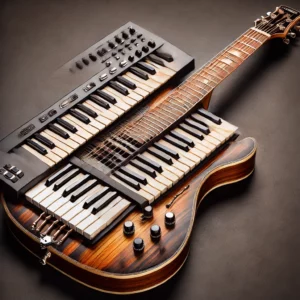Bridging the Gap Between Piano and Guitar with the Power of Music Theory
Introduction
Have you ever wondered how the piano and guitar relate to each other? While they may seem like completely different instruments—one with keys and the other with strings—they share more similarities than you might think. Understanding these connections can not only make you a better musician but also deepen your appreciation for music theory.
In this comprehensive guide, we’ll explore how the piano and guitar are interconnected, delve into fundamental music theory concepts, and provide practical tips for translating knowledge from one instrument to the other.
Video Tutorial: Exploring the Connections Between Guitar and Piano
Before we dive in, watch this in-depth tutorial that visually demonstrates the concepts discussed in this article:
The Universal Language of Music
The 12-Note Chromatic Scale
At the heart of Western music lies the 12-note chromatic scale, a sequence of twelve pitches each a semitone apart. Both the piano and guitar are built around this scale, making them fundamentally connected despite their structural differences.
The chromatic scale consists of the following notes:
C – C♯/D♭ – D – D♯/E♭ – E – F – F♯/G♭ – G – G♯/A♭ – A – A♯/B♭ – B – C
On the piano, these notes correspond to the sequence of white and black keys, while on the guitar, they are represented by each successive fret on a single string.
The Seven Diatonic Chords
In any major key, there are seven diatonic chords built from the notes of the corresponding major scale. Understanding these chords is crucial for both piano and guitar players.
The diatonic chords in C Major are:
- C Major (I)
- D Minor (ii)
- E Minor (iii)
- F Major (IV)
- G Major (V)
- A Minor (vi)
- B Diminished (vii°)
Visualising Music Theory on the Piano
The Piano Keyboard Layout
The piano’s layout makes it an excellent tool for visualising music theory concepts.
The piano keyboard consists of a repeating pattern of 12 keys: 7 white keys (C, D, E, F, G, A, B) and 5 black keys (C♯/D♭, D♯/E♭, F♯/G♭, G♯/A♭, A♯/B♭). The black keys are grouped in sets of two and three, which helps in identifying the white keys. This pattern repeats across the keyboard.
Identifying Octaves
An octave spans eight notes and is a foundational interval in music. If you start at middle C and play all the white keys up to the next C, you have played one octave. This C-to-C interval encompasses the notes C, D, E, F, G, A, B, and then C again.
Recognizing Intervals
Intervals are the distances between two notes. Starting from C:
- Major Third (C to E): Skip two white keys (D and E♭/D♯) and land on E.
- Perfect Fifth (C to G): Skip four white keys (D, E, F, and G♭/F♯) and land on G.
Building Chords on Piano
Chords are built by stacking intervals.
Major Chords
The C Major chord consists of the notes C (root), E (major third), and G (perfect fifth). On the piano, you can play these notes simultaneously to form the chord.
Minor Chords
The C Minor chord is formed by lowering the third interval by a half-step. Therefore, it consists of C (root), E♭ (minor third), and G (perfect fifth).
Seventh Chords
Adding a seventh interval introduces more complexity.
C Major Seventh (Cmaj7): C – E – G – B
C Dominant Seventh (C7): C – E – G – B♭
Translating Theory to the Guitar
The Guitar Fretboard Layout
The guitar may seem less straightforward than the piano, but patterns repeat across the fretboard.
Standard Tuning
- Strings from Lowest to Highest: E (6th string), A (5th), D (4th), G (3rd), B (2nd), E (1st)
Finding Notes and Octaves
Chromatic Scale on Guitar
Each fret on the guitar represents a half-step (semitone). Moving up one fret increases the pitch by one semitone.
Finding Octaves
An octave shape on the guitar can be found by playing a note on the 6th string and then playing the note two frets up and two strings over, on the 4th string. This shape can be moved anywhere on the fretboard.
Building Chords on Guitar
Major Chords
E Shape Barre Chord: Formed by moving the open E major shape up the fretboard and using your index finger as a barre.
A Shape Barre Chord: Similar to the E shape but based on the open A major chord.
Minor Chords
To form minor barre chords, modify the major shapes by lowering the third interval:
- E Minor Shape Barre Chord: Remove the finger that frets the major third.
- A Minor Shape Barre Chord: Adjust the fingering accordingly.
Seventh Chords
Add the minor seventh interval to the major chord shapes to form dominant seventh chords. For example, the E7 and A7 shapes are commonly used and can be moved up the fretboard as barre chords.
Chord Progressions on Guitar
Understanding chord progressions helps in playing songs and composing music.
The 1-5-6-4 Progression
The chords in the key of C Major are:
- I (1): C Major
- V (5): G Major
- vi (6): A Minor
- IV (4): F Major
Playing the Progression
These chords can be played using open chords or barre chords, depending on the desired sound and position on the fretboard.
Transposing the Progression
To change keys, move the chord shapes up or down the fretboard while maintaining the same interval relationships.
Connecting Piano and Guitar Through Music Theory

Recognizing Shared Patterns
Both instruments use the same scales and chords. Patterns on the piano can often be translated to patterns on the guitar.
Using the Piano to Enhance Guitar Skills
The piano’s visual layout can help guitarists understand music theory more clearly.
Practical Application: Learning Songs Across Instruments
Example Songs Using the 1-5-6-4 Progression
- “Let It Be” by The Beatles
- “With or Without You” by U2
- “Someone Like You” by Adele
Steps to Learn
- On Piano:
- Practice the chord progression in C Major.
- Use chord inversions to make transitions smoother.
- On Guitar:
- Practice the chord progression using open chords or barre chords.
- Experiment with different strumming patterns.
Exploring Advanced Concepts
Seventh Chords and Jazz Harmony
Seventh chords are prevalent in jazz and add richness to music.
On Piano
Practice forming major seventh, dominant seventh, and minor seventh chords. Experiment with chord voicings and inversions to create smooth progressions.
On Guitar
Learn movable chord shapes for seventh chords. Practice common jazz progressions like the ii-V-I progression.
Inversions and Voice Leading
On Piano
Inversions involve rearranging the notes of a chord so that different notes are in the bass. Voice leading focuses on smooth transitions between chords by minimizing the movement of each note.
On Guitar
Use different chord voicings and partial chords to achieve smoother transitions. Explore triads and inversions on higher strings.
Practical Tips for Musicians
For Guitarists Learning Piano
- Start Simple: Begin with major scales and simple chords.
- Visualize Patterns: Relate fretboard patterns to keyboard layouts.
- Practice Ear Training: Match notes and chords between instruments.
For Pianists Learning Guitar
- Learn Basic Chord Shapes: Start with open chords before moving to barre chords.
- Understand Fretboard Logic: Recognize how scales and intervals are laid out.
- Develop Finger Strength: Practice regularly to build the necessary dexterity.
Conclusion
The piano and guitar are more connected than they appear. By exploring the similarities in their scales, chords, and progressions, you can deepen your understanding of music as a whole. Whether you’re a guitarist looking to unlock new perspectives or a pianist eager to expand your skills, embracing the interconnectedness of these instruments will elevate your musicianship.
Take the Next Step in Your Musical Journey
Are you inspired to bridge the gap between piano and guitar? Do you want to become a more versatile musician?
Join us at the London Contemporary School of Piano. We offer personalised courses tailored to your musical interests and goals. Let’s explore music theory together and unlock your full potential.
Contact us today:
- Website: www.contemporaryschoolofpiano.com
- Email: [email protected]
Discover how understanding the synergy between piano and guitar can transform your musical experience.
Additional Resources
- YouTube Channel: Explore our detailed tutorials on scales, chords, and progressions
Frequently Asked Questions
1. Is it hard to learn piano if I already play guitar?
Not necessarily. While the techniques differ, your understanding of music theory from guitar can help you learn piano more quickly.
2. Do I need to read music to understand these concepts?
Reading music is helpful but not essential. Many concepts can be learned through patterns and auditory recognition.
3. Can learning piano improve my guitar playing?
Yes. Piano can enhance your grasp of music theory, which in turn can improve your guitar playing.
Keywords Recap: piano and guitar similarities, music theory for guitarists, piano lessons for guitar players, chord progressions, major and minor chords, seventh chords, music intervals, learning piano and guitar, connecting instruments, music theory anxiety.
